#charles perrault
Text
WAIT WAIT WAIT

YOU'RE TELLING ME
THE TITLE CARD FROM CINDERELLA (1950) EXPLICITLY SAYS IT'S BASED ON THE PERRAULT VERSION OF THE STORY???
WE COULD HAVE AVOIDED ALL THE SANCTIMONIOUS EDGELORDS SMARMING ABOUT HOW "well Disney toned it down; the One True Grimms' Original akschully has blood and no fairy and feet getting cut up, so there" IF THEY HAD JUST
BOTHERED TO PAY ATTENTION TO THE MOVIE AND THEN GOOGLE "PERRAULT CINDERELLA???"
excuse me I need to go scream into a pillow
(I'm not saying Ashenputtel isn't possibly older as a folktale than its 1812 publication date in the Grimms' book, but Perrault's version was published in the 1690s. so...)
#fairytales#folktales#cinderella#disney#charles perrault#the brothers grimm#and if you're obsessed with originality. the earliest recorded version of the story is like a paragraph long and completely bloodless#'there was a lovely courtesan. an eagle carried one of her sandals to Pharaoh. he used it to find her and married her. The End."#(Rhodopis if you want to look it up)
2K notes
·
View notes
Text
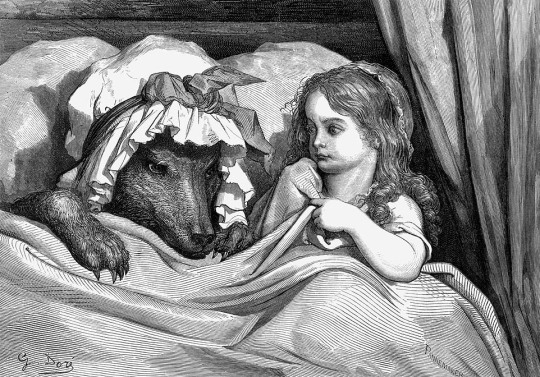
She was astonished to see how her grandmother looked, illustration by Gustave Doré from Les Contes de Perrault, 1862
#art#art history#Gustave Doré#illustration#black and white#b&w#Red Riding Hood#Little Red Riding Hood#fairy tales#Charles Perrault#Symbolism#Symbolist art#French art#19th century art
505 notes
·
View notes
Text
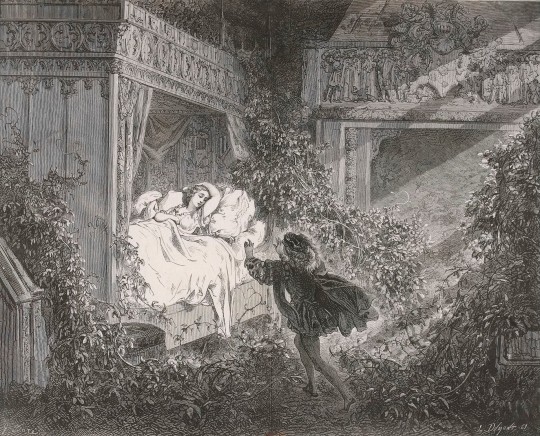
The Sleeping Beauty by Gustave Doré
"Reclining upon a bed was a princess of radiant beauty."
The Sleeping Beauty, La Belle au Bois Dormant, The Beauty in the Sleeping Forest, The Sleeping Beauty in the Woods, Dornröschen, Little Briar Rose.
#the sleeping beauty#sleeping beauty#art#gustave doré#charles perrault#illustration#fairy tale#fairy tales#les contes de perrault#la belle au bois dormant#princess#prince#forest#woods#forests#woodland#palace#europe#european#cursed#sleep#sleeping#folklore#medieval#middle ages#fairy#fairies#history#bed#enchanted
2K notes
·
View notes
Text

Charles Perrault
Contes du temps passé
Librairie Delagrave
1925
Artist : Maurice Berty
#maurice berty#charles perrault#fairy tale#children's literature#children's illustration#children's books#vintage illustration#fairy story#children's book#fairy tales#old illustration#fairy#1925#prince#princess#lake#lac#deer#white castle#night#moon#lune
309 notes
·
View notes
Text
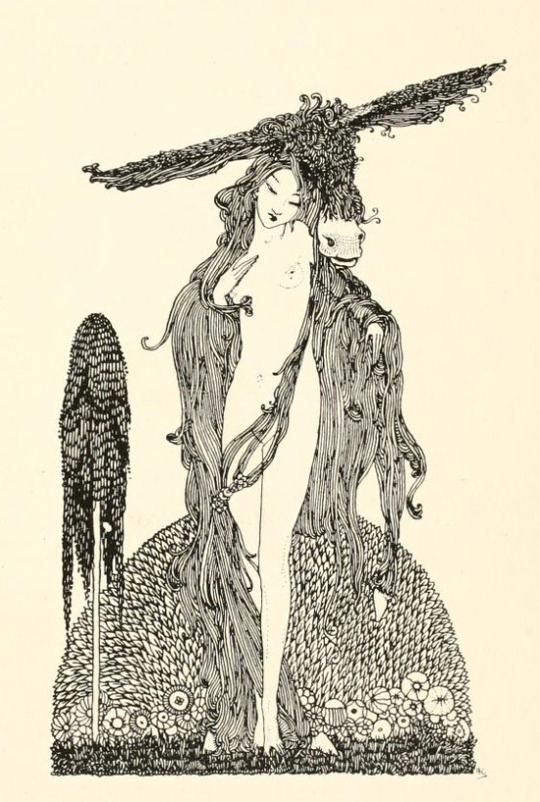
Donkeyskin, from The Fairy Tales of Charles Perrault by Harry Clarke (1922)
#harry clarke#art#illustration#golden age of illustration#1920s#1920s art#vintage art#vintage illustration#vintage#irish art#irish artist#books#book illustration#fairy tale#fairy tales#fairytale art#charles perrault#donkeyskin#art nouveau#classic art
1K notes
·
View notes
Photo
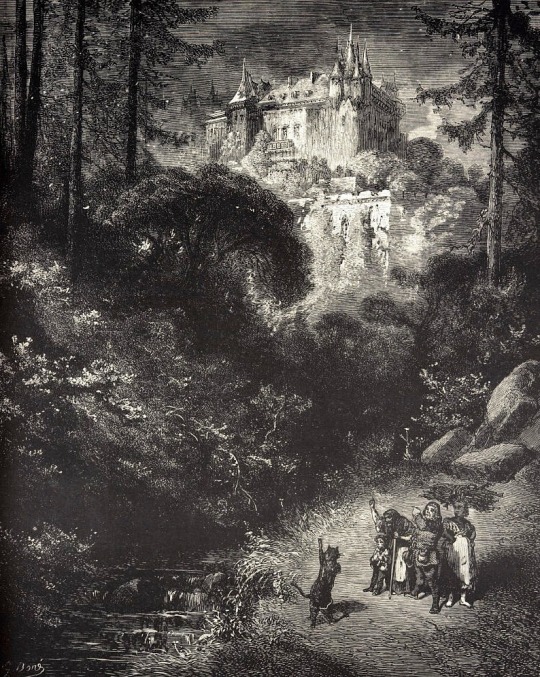
'Puss in Boots' from Charles Perrault's Fairytales, illustration by Gustave Dore (1862-1867)
2K notes
·
View notes
Text
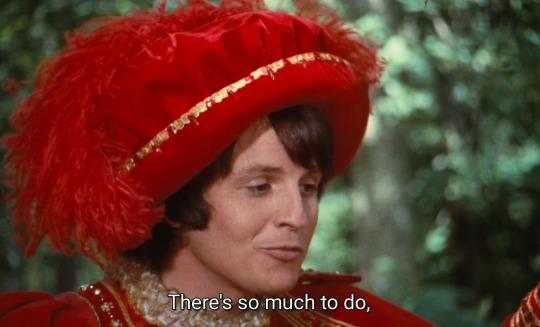
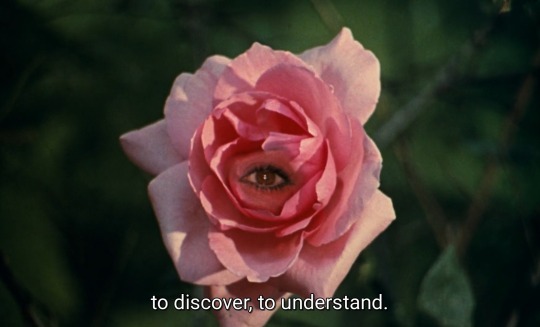
donkey skin (1970) dir. jacques demy
#peau d'âne#donkey skin#jacques demy#catherine deneuve#jean marais#charles perrault#film aesthetic#film stills#film#film quotes#french cinema#french film#french musical#french films#film quotations#fantasy#70s film#70s cinema#70s style
247 notes
·
View notes
Text
Do you love fairy tales? I want to hear from you!
EDIT: I will be closing the survey on November 9th! Thank you everyone who has participated!!!
My name is Ainjel Stephens and I am a PhD candidate in the Folklore department at Memorial University of Newfoundland. I am currently conducting a research project on fairy tales reception by queer-identifying individuals for my PhD dissertation under the supervision of Sarah Gordon. The purpose of this study is to learn how people who feel queer or identify as queer think about and respond to fairy tales.

Artist: Gustave Dore
If this sounds like a project you would be interested in participating in, then I invite you to take a short survey where you will be asked a few questions about who you are, as well as reflective questions about your thoughts and feelings on fairy tales, and if these tales are “queer.” It should only take about 10 minutes of your time to complete.
The survey asks if you would like to participate further with an interview with myself in order to discuss your thoughts and opinions on fairy tales. This interview will be a recorded hour-long interview through video conferencing platform Tauria or Webex. If you select yes, I will be in contact with you with further steps. If you select no, then that’s it! Thank you for participating.
To participate, you must be the age of majority and no younger than 19, have fairy tale knowledge in English, and identify with the term “queer.”
If you are interested, click the link below to participate in the anonymous survey.
If you have questions or want to chat further, you can contact me at [email protected] or through my inbox on my project blog, www.diamondsandtoads.tumblr.com/
If you know anyone who may be interested in participating in this study, please send this post along.
Thank you for reading!
The proposal for this research has been reviewed by the Interdisciplinary Committee on Ethics in Human Research and found to be in compliance with Memorial University’s ethics policy. If you have ethical concerns about the research, such as your rights as a participant, you may contact the Chairperson of the ICEHR at [email protected] or by telephone at 709-864-2861
#fairytales#fairy tale retelling#queer#lgbt#lgbtq community#beauty and the beast#cinderella#little red riding hood#charles perrault#grimms#grimm fairy tales#queer fairy tale#diamonds and toads#folklore#folktale#snow white#sleeping beauty#queer writers#queer community#lgbt community#the princesses#academia#queer fairytales
255 notes
·
View notes
Note
This might sound stupid, but what are the characteristics of fairytale ogres, particularly how Charles Perrault describes them?
There is no stupid question on this blog! (Except if someone really pisses me off, then all their questions will be stupid)
It is quite easy to answer this because we only have three ogres in all of Perrault's fairytales, so identifying the main traits is fast. They come from "Puss in Boots", "Little Thumbling" and "Sleeping Beauty". I'll recap shortly.
Eat humans. That's the main trait of an ogre. They eat human flesh, though they don't eat all the humans they see on the spot, mind you. Ogres prefer the flesh when it is young, tender, fresh and pretty. So they prefer pretty young people (Sleeping Beauty) to ugly old ones (that's what spares the ogre's wife, her age, she is too old to be edible). And this is why they go crazy over children, which for them is the most delicious meat. Literaly: the ogres are repeatedly said to be literaly jumping on children as soon as they see them, and to always want to eat them on the spot. (Another ogre trait: they are not very patient beings, and they have a hard time waiting)
Even outside of eating humans, they tend to be food-obsessed people - ranging from Little Thumbling's ogre who eats enormous quantities of food (entire animals to himself), to the ogress-queen who insists on having the most fashionable and delicious sauces with her meals.
Ogres are wealthy, and powerful in a social or political way. People tend to forget this, but the ogres of Perrault range from a literal queen (who was married by the king because of her immense wealth) to a lord who owns so many lands even the king is amazed. We don't know the social class of Little Thumbling's ogre, but he still lives in a large mansion and owns a huge treasure. Insert your joke of "the rich eat the poor" (except ogres also eat the rich - see the Sleeping Beauty case)
Ogres have something magical to them, ranging from owning magical items (Little Thumbling's seven-league-boots) to having actual magical powers (Puss in Boots' ogre is a shapeshifter)
Ogres are wicked and bad people who collect all sorts of vices, but they are all painted as brutal bullies, and as cruel beings who delight in scaring people or making them suffer. Oh yes, and if you cross an ogre, they will hunt you down mercilessly to enact their revenge, because ogres are very vengeful (see the ogre's hunt for Little Thumbling and his brothers, or the ogress' decision to have everybody executed for deceiving her)
When ogres have a family, they have a... very bizarre and complicated set of relationships mixing fear and love and abuse and familial respect. On one side, we have an ogre who is an abusive husband (and yet told to be a good husband enough that his wife loves him very much), and adores his daughters (he only eats them by accident) ; on the other, an ogress who lives peacefully with her husband, who refuses to harm or upset her son (son who both loves her a lot and still fears her), but who wishes to kill on the spot her daughter-in-law and grandkids... Oh and they are known to apparently regularly invite over friends to share their meals (at least if they don't end up devouring the planned meal before the guests arrive)
Are ogres giants? In Perrault's fairytales, no. Everybody knows of Gustave Doré's famous illustrations depicting ogres as giants, but this comes from A) other authors depicting ogres as giants and B) oral/popular/folkloric fairytales and legends mixing ogres and giants. So by the time Gustave Doré illustrated the fairytales, ogres were thought of as giants - but Perrault never writes anything about them being giants, and in the first illustrations of his fairytales they are depicted human-sized. At most he implies that the ogres are big/large/tall/heavy beings, but no different from a big, tall man.
Unlike the modern idea that ogres are inhuman monsters - in Perrault's fairytales, everything indicates that ogres look a lot like humans, and are very close to them. They are inserted in the human society as kings and queens (unlike fairies for example who are "outside" elements), they can crossbreed with humans (and if Sleeping Beauty is any clue, half-ogres looks so much like humans you can't tell they're ogres), and in the case of the ogress-queen, only her intimates know about her ogress nature - the rest is just unconfirmed rumors running around the court. (And Gustave Doré had caught on this, which is why he had his ogres looking like almost regular people). Perrault himself defines ogres in his notes as "wild men/savage men".
The only physical traits Perrault indicates about ogres (beside them having booming voices, and possibly being quite large and big people), are facial traits. They all come from the little ogresses' descriptions in Little Thumbling. Three of them are said to make ogresses "ugly" by 17th century standard - a hooked nose, round grey eyes, and a very large mouth filled with long, spaced-out sharp teeth. A fourth however is said to make them pretty by those same standards - because their diet of meat and flesh gives them a "pretty skin tone/beautiful colors/a healthy skin color".
If the same Little Thumbling fairytale is to be believed, ogre-children start their cannibalistic diets by sucking up the blood of little children. Then they presumably move to eating the children - but in their early years they just bite like vampires.
Oh yes and how could I forget. THE other main defining trait with their gluttonous cannibalism: their sense of smell. Ogres can smell "fresh meat" (la chair fraîche is the consecrated French expression). It is how the ogre of Little Thumbling guesses there are children hiding in his house, he smells them, and the ogress-queen is also said to go randomly go in the courtyard to sniff out animals like a wild beast.
I think these are pretty much the big defining traits of ogres in Perrault's fairytales. Of course, I simplified stuff, but this is the core knowledge to have about what ogres ~ Perrault style ~ are.
72 notes
·
View notes
Text

Gustave Doré (1832-1883)
"Little Red Riding Hood" (c, 1862)
Oil on canvas
Located in the National Gallery of Victoria, Melbourne, Victoria, Australia
Doré has depicted Charles Perrault’s original "Little Red Riding Hood" of 1697 – rather than the later, sanitized versions, mainly for British audiences – and depicts the story’s penultimate moment, just before the wolf bites off Little Red Riding Hood’s head.
Terror was often a key component in fairy tales which also had a moralizing element or subtext; romantic artists were drawn to these darker aspects of tales written for children.
#paintings#art#artwork#literary painting#fairy tales#gustave doré#gustave dore#oil on canvas#fine art#national gallery of victoria#museum#art gallery#french artist#charles perrault#little red riding hood#wolf#history#child#children#animals#1860s#mid 1800s#mid 19th century#october#halloween
186 notes
·
View notes
Text
In Heidi Ann Heiner's Cinderella Tales From Around The World, I've now read the variants from Germany, Belgium, and France.
*Of course the most famous German Cinderella story is Aschenputtel by the Brothers Grimm. If you don't know it from reading it, you probably know it from Into the Woods, and if you don't know it from there, you've probably heard of it in pop culture. Too many people mistakenly think it's the "original" version of Cinderella. But there are other German Cinderella stories too – all similar to the Grimms' version, but with differences here and there.
*In nearly every German version, and in both of the two Belgian versions the book features, the heroine gets her elegant gowns and shoes from a tree. It throws them down to her, or opens up to reveal them, after she either recites a rhyme underneath it or knocks on it.
**Some variants, like the Grimms', have the archetypal "father goes on a journey and asks for gift requests" plot line, and the heroine gets a hazel twig, which she plants on her mother's grave and which grows into a tree. But in other versions, the tree is seemingly a random one, which either a dove, a dwarf, or a mysterious old man or woman advises her to ask for finery.
**That said, there's one exception: a German version called Aschengrittel, where the heroine meets a dwarf who, like the fairies in some Italian versions, gives her a magic wand to grant her wishes.
*As in the Egyptian, Greek, and Italian versions, it varies whether the German versions have the heroine abused by a stepmother and stepsister(s) or by her own mother and sister(s), whether her father is alive or not, and whether the special event she attends is a royal ball/festival or a church service. In both of the two Belgian versions, the heroine's abusers are her own mother and sister(s).
*While in the Mediterranean versions, the heroine's future husband is always either a prince or (more rarely) a king, in the German versions he's occasionally a knight or a rich merchant instead.
*Other typical German and Belgian details are (a) the (step)mother forcing the heroine to sort lentils, seeds, or grain, usually by picking them out of the ashes, which is usually resolved by birds doing the job for her, (b) the prince (or king, or merchant) having the palace or church steps smeared with pitch so that the heroine loses her shoe, and (c) the notorious detail of the (step)sisters cutting off parts of their feet to make the shoe fit, which is revealed when either birds or a dog call out that there's blood in the shoe.
**One Greek version has the prince catch the heroine's shoe by having the church steps smeared with honey, but the Mediterranean Cinderellas usually lose their shoes either by accident or by choice, while in Germany and Belgium it's usually the prince's doing.
**The foot-cutting episode is clearly typical of German and Belgian versions, but the Grimms' other notorious detail, where the stepsisters' eyes are pecked out by doves at the end, isn't typical. The Grimms themselves added that grisly detail to give the story a more "moral" ending with the stepsisters appropriately punished.
*The Grimms' footnotes for their version are included in this book. They mention several other German variants, including two that continue after the heroine's marriage and have the stepmother and stepsister try to murder her, and one where the stepmother starts out as the heroine's childhood nurse and murders the girl's mother by pushing her out a window, then claims she committed suicide.
*The German, Belgian, and French Cinderellas aren't quite so cunning and unfazed as the Greek and Italian Cinderellas. Now we see more heroines who cry over their hardships, and/or who beg to be allowed to go to the ball/festival or church, and whose magical help is more given to them and less in their own control. One notable French exception to this pattern, though, is Madame d'Aulnoy's cunning and self-reliant Finette Cendron.
*France doesn't seem to have the same pattern of culturally-distinct oral versions of this tale that other countries do. Instead, the French examples in this book are nearly all literary versions, and each one is almost completely different from the others.
**Of course the most wildly famous and important French Cinderella is Charles Perrault's Cendrillon. This is the Cinderella we all know best, with the fairy godmother, the pumpkin coach, the magic only lasting until midnight, and the glass slipper.
**Published in the same year as Perrault's version was Madame d'Aulnoy's Finette Cendron. This is an interesting, much longer variation that starts out as a Hop o'My Thumb/Hansel and Gretel story, where three sisters are abandoned in the woods and nearly eaten by an ogre, only for the clever youngest, Finette, to outwit him, but then turns into a Cinderella story when the older sisters abuse Finette after they make the dead ogre's castle their home, but Finette follows them to a ball in finery she finds in a chest.
**Another French literary variant is The Black Cat, which starts out as a Cinderella tale, but then has the heroine be stranded on an island and give birth to a black cat son (long story), then turns into a Puss in Boots tale as the cat helps his mother. Yet another is The Blue Bull, where the heroine runs away from her stepmother with her only friend, a magical bull, only for the bull to be killed protecting her from lions, and which then becomes a Donkeyskin/All Kinds of Fur-type of story, where she becomes a servant at the prince's palace and gets her ballroom finery from the bull's grave.
*Perrault and d'Aulnoy's versions are the only two Cinderellas so far where the heroine has a fairy godmother. Yes, in some others there are fairies or mysterious old women who help her, but the concept of a fairy godmother seems to have French literary origins.
*These same two versions, Perrault's and d'Aulnoys are also where we first see strong emphasis on the heroine's virtue and kindness, even to her cruel (step)family. While some oral versions do have her forgive them in the end, these literary versions not only have her do that, but have her constantly be gracious and kind to them (Perrault) or save their lives even at great personal sacrifice (d'Aulnoy).
*Now that I've read Finette Cendron, I can see its slight influence on Massanet's opera Cendrillon. In Finette Cendron, instead of Perrault's choice to have the slipper taken from house to house, all the ladies are invited to the palace to try it on, and Finette's fairy godmother sends her a horse to ride there – just like Cinderella's fairy godmother transports her to the slipper-fitting at the palace in the opera. Finette Cendron's Prince Cherí also falls deathly ill with love for the mystery girl, but is cured when he finds her. (A recurring theme in many different variants, which I forgot to mention when I covered the Mediterranean versions.) In the opera, this has its parallel when Prince Charming faints in despair over the seeming failure of the slipper-fitting, and before that when Cinderella herself becomes gravely ill because she thinks she'll never see her prince again.
@adarkrainbow, @ariel-seagull-wings, @themousefromfantasyland
#cinderella#fairy tale#variations#germany#belgium#france#the brothers grimm#charles perrault#madame d'aulnoy#cinderella tales from around the world#heidi ann heiner#tw: violence#tw: murder#tw: suicide mention
60 notes
·
View notes
Text

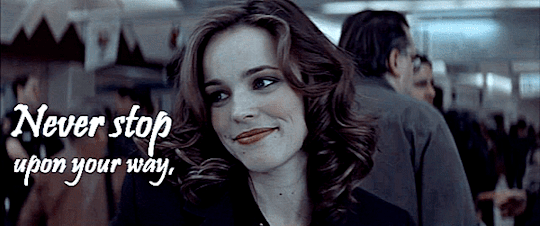

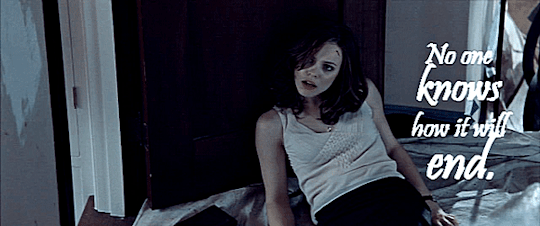



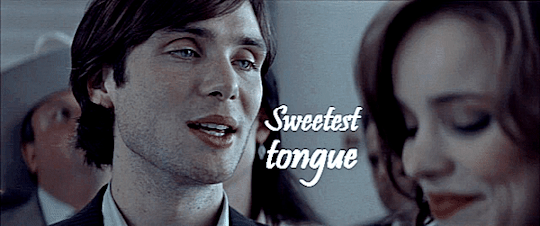

Red Eye + The Moral of Little Red Riding Hood by Charles Perrault
#red eye#red eye 2005#little red riding hood#the company of wolves#lisa reisert#jackson rippner#jackson x lisa#cillian murphy#rachel mcadams#wes craven#carl ellsworth#charles perrault#coloring: ashes and wine by oceanbreeze/coloursoftheocean#these lines open my fanmix for a reason UwU#too bad i have no idea who's the translator
118 notes
·
View notes
Text
Once you know that Marissa Meyer based The Lunar Chronicles (and specifically Cinder, the first book) on an old Sailor Moon fanfic she wrote, the inspiration can be fairly obvious (most obvious being the missing princess from the moon and the threat of war between Earth and the Moon). That being said, there’s enough of Meyer’s own inspiration/ideas in there to help make it stand out (the futuristic setting, for one thing).
But it did make me think: Bill Ellis (who I mentioned on here before) wrote an essay about Princess Tutu where he said that Cinderella--the fairy tale Cinder retells--is an archetypal precedent to magical girl transformations. Cinderella and Sailor Moon have premises unique to themselves, but then I thought about the basics of both stories: both Cinderella and Usagi start out as girls who are at a low point of their life (Cinderella is mistreated by her stepfamily, while Usagi is chronically late for school and failing tests--one is arguably worse than the other, sure, but the point is, neither of them is doing great in their own way). Then both of them encounter magic (fairy godmother, talking space cat, etc.) that gives them, as Ellis puts it, the skills they need to accomplish whatever they need to do (go to the ball, fight evil). For an added bonus, no one at the ball ever recognizes Cinderella, similar to how no one ever puts it together that Usagi is Sailor Moon, despite her never covering her face (though she did have a mask in the early chapters of the manga). Also, there’s a prince in both stories.
With that in mind, it’s not hard to see how it was easy for Meyer to take inspiration from Sailor Moon in her Cinderella retelling. (Interestingly enough, the original fanfic was a Puss in Boots AU, because as Meyer pointed out, both Puss in Boots and Sailor Moon have talking cats.)
#the lunar chronicles#cinder#sailor moon#bishoujo senshi sailor moon#usagi tsukino#linh cinder#marissa meyer#naoko takeuchi#cinderella#charles perrault#magical girl#magical girls#fairy tales#retellings#bill ellis#princess tutu#random thoughts#text#I don't know if I ever specified on here#but I am a Sailor Moon fan#just finally got around to watching the new adaptations
213 notes
·
View notes
Text
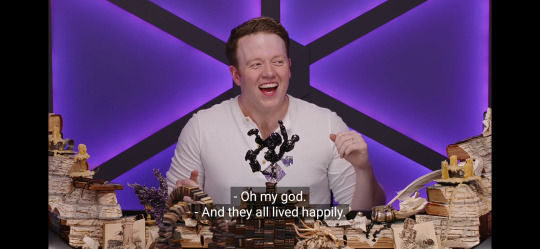

I've just finished Neverafter, so here are my thoughts on The Big Bad Wolf and Ylfa and what their relationship reveals about The Neverafter itself. I think the most important reveal we get is in S1E9: Origins, when the group witness the moment when Ylfa consumes the wolf.
Brennan said "you think this is a version of Red's story which went very wrong", and the fairy with the turquoise hair (who is herself only an echo of the blue fairy she is supposed to be) tells them that Ylfa met "a version of The Wolf that was much older and ancient". This was caused by (and also foreshadowing) the reveal that the Baron of Bricks was boiling down the essence of The Big Bad Wolf: As the more recent, tamer versions of the wolf got stripped away, all that was left was this primal creature: the one that was most like a wolf.
When the characters question if some versions of their stories come from the Auroratory rather than The Ink, I believe this is true- the ink merely preserves the stories for longer so that other storytellers can read them, which, in turn, reinforces the narratives.
Anyone in the "real world' can be a storyteller: in The Auroratory, when Ylfa hears all the voices telling the different versions of her story, the first one she hears as she begins to panic and worry that she's corrupting the stories is a man's voice talking impatiently and hurriedly, saying “the little girl strayed from the path and got eaten”- which, of course, isn't what happened in the true tale of Red Riding Hood- at least, not in the one I heard as a kid. The little girl strayed from the path, and then she got eaten. The difference is important. She strayed from the path, yes, but she didn't get eaten until later.
But the version of the story Ylfa experiences isn't similar to that, either.
The original story of Red Riding Hood existed as oral tradition long before it was written down, but it's thought that the first written version was penned by Charles Perrault, in 1697. In his version, the wolf tells Red that he'll race her to her grandma's house, and makes sure to take the shorter path so he gets there before her.
Ylfa's version of the story is never told in its entirety, but, from the snippets we get, it doesn't seem to match this story (aside from Ylfa's comment about watching “a caterpillar chase a butterfly”, because in the Perrault version she slowed down to watch burterflies). It seems that Ylfa never met The Wolf until she got to her grandmother's house, and we all know the woodsman wasn't nearby to deter him. So, what would have happened if Ylfa hadn't strayed from the path and gotten to the house late?
Ylfa often talks about how most versions of her story discuss the importance of not straying from the path, but, the truth is, if she hadn't strayed from the path, she wouldn't have survived.
Death is a Big Bad Wolf, but- in this instance- Death waits for her, and Ylfa becomes The Wolf.
In the finale, the characters (protagonist and antagonist alike) all worry about the nature of free will and predestination, but- through their ending- they choose to commit a different version of themselves to paper: a version which will then be retold and reinforced by someone reading it. Their stories will change again, with time and retelling, but, for now, they are in control of a tiny piece of their narrative.
Ylfa strays from the path, but she doesn't get eaten.
And that's where we'll end our story.
#Neverafter#Neverafter spoilers#Dimension 20#dimension 20 neverafter#ylfa snorgelsson#neverafter ylfa#emily axford#brennan lee mulligan#Neverafter thoughts#Neverafter meta#Neverafter finale#Little Red Riding Hood#Charles Perrault#Tales Of Mother Goose#Neverafter Origins
113 notes
·
View notes
Text
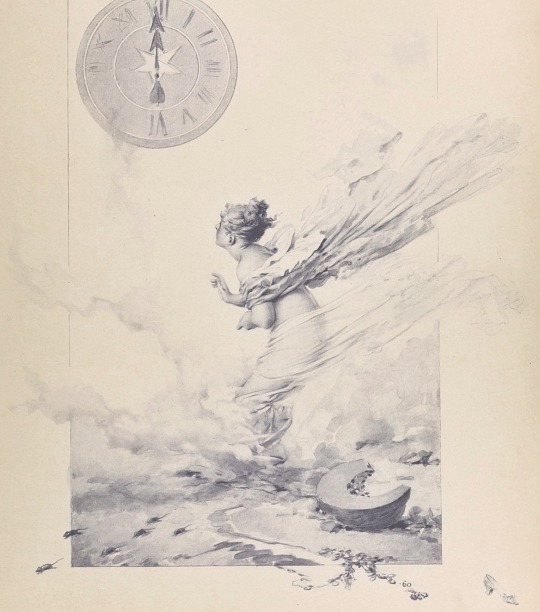
Cendrillon / Cinderella
Quatre contes de Charles Perrault
1888
Artist : Édouart de Beaumont
#cinderella#cendrillon#children's literature#charles perrault#édouart de beaumont#1888#potiron#pumpkin#mouse#mice#souris#rats#time#heure#bal#midnight#night#children’s literature#fairy tale#vintage illustration#children's book#old illustration#old book#19th century
297 notes
·
View notes
Text
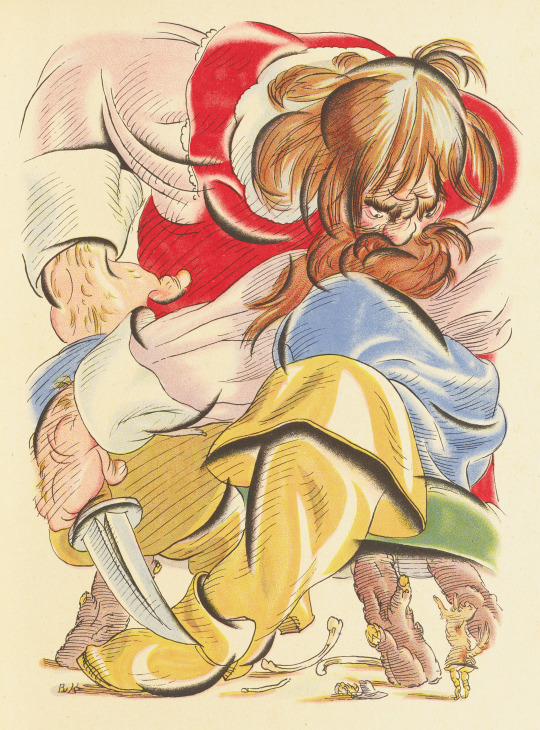
Vladimir Konashevich (1888-1963), ''Kot v sapogakh'' (Puss in Boots), 1922
Source
#Vladimir Konashevich#Vladimir Mikhaylovich Konashevich#russian artists#puss in boots#children's books#charles perrault#Perrault's telling of this tale is the most famous so Perrault gets the tag
48 notes
·
View notes